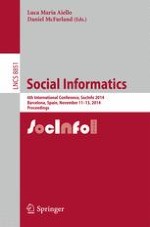2014 | Buch
Social Informatics
6th International Conference, SocInfo 2014, Barcelona, Spain, November 11-13, 2014. Proceedings
herausgegeben von: Luca Maria Aiello, Daniel McFarland
Verlag: Springer International Publishing
Buchreihe : Lecture Notes in Computer Science
